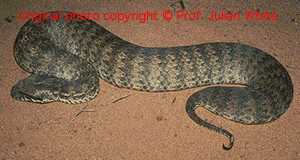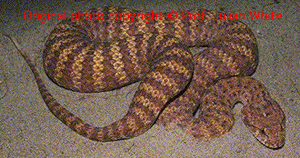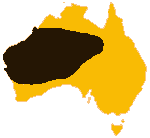





Used for neutralising systemic envenoming by members of the Australian death adder group. It is made from horse IgG. Each ampoule contains 6000 units of neutralising capacity against the target venoms. Average volume per ampoule is 25-26mL. The immunising venom is from the common death adder.
Death adders are distinctive snakes, with triangular heads, squat bodies, and thin tails, sometimes used as a lure. They are the only dangerous Australian venomous snake habitually nocturnal, though most other species will be active on hot nights. They are also known as "deaf" adders, with good reason. Like all snakes, they lack external ears and so rely on vibration rather than hearing to detect the approach of large animals, including humans. All other dangerous Australian snakes will usually try and move away from a potential threat. Death adders often rely on camouflage, burrowing deeper into leaf litter or other ground debris, rather than moving out of the way. If stepped on they will bite rapidly and effectively. It is therefore fortunate that death adders seem to have adjusted poorly to human encroachment on their environment. In many parts of southern Australia, at least, their range is contracting. They are a rather infrequent cause of bites now.
 |
Common death adder Acanthophis antarcticus |  |
|
 |
Desert death adder Acanthophis pyrrhus |  |
|
| (no photo) | Northern death adder Acanthophis praelongus |  |
|
| (no photo) | Pilbara death adder Acanthophis wellsii |  |
Death adders are found in a variety of habitats, both arid and temperate to tropical, but in most parts of their current range, they are infrequently encountered. In some areas this is due to contracting populations of these snakes, but in other areas it is more likely due to their cryptic habits. They are not found in Tasmania or the islands off the southern coast.
Death adders have large fangs, producing a considerable quantity of toxic venom. However, in humans, the only major effect of this venom appears to be post synaptic neurotoxic paralysis. The venom does not contain either procoagulants or myolysins of significance.
50 to 100 years ago, death adder bites were greatly feared, carrying a 50% mortality rate, due to profound paralysis. With current medical facilities, paralysis should be a non-lethal complication of snakebite in all but the most exceptional of cases, therefore death adders should no longer be considered near the top of the list of Australia's dangerous snakes. Current statistics tend to confirm this view. Many bites should result in systemic envenoming, but in practice, at least in urban areas, nearly all bites are from captive specimens and usually are trivial. Where venom has been injected, there is often local pain and mild swelling, followed by progressive development of paralysis over the next few hours, starting with ptosis, then affecting other cranial nerves, peripheral muscles, and finally, if untreated, respiratory muscles. Major respiratory paralysis can occur within 6 hours of the bite. Defibrination coagulopathy, myolysis and major kidney damage do not occur, although the latter might conceivably occur as a secondary complication.
As with most antivenoms, CSL Death Adder Antivenom should only be given if there is clear evidence of envenoming. See potential contraindications. It should be given intravenously, through a drip set. If possible, dilute antivenom up to 1 in 10, with an isotonic crystaloid solution (eg. saline, Hartmans or dextrose). In general, each ampoule/dose should be run over 15-30 minutes. Prior to commencing antivenom therapy, make sure everything is ready to treat anaphylaxis, should this occur. Specifically, have adrenaline ready to give. If there is an infusion pump available, have this set up to run through a side arm of the drip set, with a solution of dilute adrenaline (eg 6mg adrenaline in 100mL of saline or 5% dextrose, or equivalent dilution). Clearly mark this pump, so that it is not accidentally started.
The use of adrenaline as pre-treatment when using antivenoms is still being debated. The risk of anaphylaxis varies from antivenom to antivenom. People who have had previous exposure to equine derived products may be at greater risk. It is recommended that the Product Information be read before use and if necessary contact be made with a specialist in the field.
The indication for antivenom therapy in death adder bite is relatively simple; at the earliest sign of paralysis (usually ptosis), antivenom should be given. The specific antivenom is CSL Death Adder Antivenom, and 1 vial is often sufficient. If the paralysis progresses despite the initial dose, give a second vial. Because the neurotoxins in this venom are post synaptic, non-antivenom treatments for paralysis may also be effective if antivenom is not readily available. Specifically, anticholinesterases (eg neostigmine) may retard or even reverse development of paralysis by making more acetylcholine available as transmitter at the neuromuscular junction, allowing the post synaptic blockade to be overcome.
Any patient who has received antivenom may develop serum sickness, from 4 to 14 days later. Before leaving hospital, they should be advised of the symptoms of serum sickness, such as rash, fever, joint aches and pains, malaise, and told to return immediately for review and probable commencement of oral steroid therapy. If there was major envenoming, organise follow up. This is usually not necessary for minor envenoming. It may be useful to give a 5 day course of oral steroids as prophylaxis for serum sickness (eg 30-50mg daily of prednisolone, for adults).